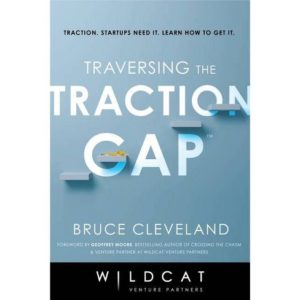In “The Traction Gap” Bruce Cleveland explains how to find a minimum viable product and grow a company with a repeatable sales process.
 Traversing the Traction Gap
Traversing the Traction Gap
by Bruce Cleveland
Recently we had a roundtable discussion about the book “Traversing the Traction Gap” by Bruce Cleveland. The video has insights that attendees found valuable and how they have applied them to their own startup. We believe that “The Traction Gap” offers a valuable framework for how to take your minimally viable initial product and grow it into a company with a repeatable scalable sales process.
Traction Gap offers insights into B2B VC mindset
In the video snippet below, David Robson shares the insights that book gave him into how VCs looks at startup investments.
Full discussion
Here are two cheat sheets and a video presentation by Bruce Cleveland on the book if you would like more context before coming to this discussion
- https://wildcat.vc/wp-content/uploads/2017/09/Traction-Gap-Framework-9.14.17.pdf in particular page 3 for an overview of category selection, product definition, and business model reinforce each other over time.
- http://tractiongapbook.com/wp-content/uploads/2019/03/Traction-Gap-Reference-Sheet_F_3-2019.pdf in particular page 2 for a holistic view of how team, product, systems, and revenue interact.
Bruce Cleveland’s 2019 Talk at Lean Culture
“Traversing the Traction Gap” is one of our must read books for startups. Others can be found at https://www.skmurphy.com/blog/category/books/
Key Message of Traction Gap is Value of Early Market Research
In an April 2019 interview with M.R. Rangaswami in SandHill.com. Bruce Cleveland made the following observations:
- To be ready to make the journey from concept to traction, you should have completed all market engineering and product engineering tasks. Your market engineering tasks include category creation/definition, statistically valid market research to confirm there is a legitimate and sizeable market, initial messaging matrix and value propositions, initial pricing and your talk tracks – thought leadership, sales leadership and investor.
- If the research is done correctly, then market need can usually be established quite early – just after Ideation. The challenge at this early stage – especially with truly innovative offerings – is to not describe the product/solution to the potential buyer/user. Instead, the team should describe the problem or concept and statistically validate there are enough people or companies with enough interest to purchase and/or use the solution at varying price points.
- Most startup teams don’t have the internal resources – expertise or capital – to perform statistically valid market research. In fact, most large companies don’t possess these resources either. And even if they do, the pressure from investors or executives to “get on with it” tends to reduce what should be full market research into just customer research (the market is far bigger than your customers, if you have any). Worse still, full market research gives way to research that involves a handful of customers, and this is then presented as statistically valid to the investors or executives expected to finance and support the development.
- A recent study of more than 3,000 companies showed that, on average, most of them surveyed 10 or fewer customers. This so-called “market research” then served as the basis for committing these companies to millions of dollars in downstream development, marketing, sales, training and support costs.
- There is no substitution for intuition. That unique insight that someone, or some team, has when experience meets inspiration. This is the art. You want to encourage it, but not be a slave to it. You need to apply process to validate whether your intuition is correct. CPG (consumer packaged goods) companies have developed very formal processes to validate their intuition. Procter and Gamble are probably the best of the bunch at it. They would never launch a new product idea before doing a lot of market testing. I would argue that since 80 percent or more of the tech startups fail, they don’t really possess some sort of magical skill that allows them to bypass this critical work.
Related Blog Posts and Reference Material
- Traction Gap Book Website https://tractiongapbook.com/
- WildCat VC Traction Gap Resources and Traction Gap News
- Your First Dozen Enterprise Customers
- Why is an Enterprise Sale So Complex?
- Why is it so hard to get your first ten customers?
- Landing Your First Ten Customers: Videos, Slides, and Other Resources
- 40 Tips for B2B Customer Development Interviews
- Zoom In For Traction, Zoom Out For Impact (related testimonial Zoom In for Traction, Then Slowly Zoom Out for Impact)
